When visiting Hoi An Ancient Town, a tranquil small town nestled beside the Hoai River, tourists will have the opportunity to discover some very famous historical sites, and one that cannot be overlooked is the Fukian Assembly Hall in Hoi An. Originally constructed by Chinese merchants, it has now been renovated and meticulously maintained. It contributes to giving Hoi An Ancient Town a fresh, vibrant, and more appealing appearance.
Fukian Assembly Hall (Phuc Kien) in Hoi An is a famous tourist destination in Hoi An and has become an attractive site for both domestic and international visitors. Let’s explore this landmark with DanangPrivateCar.com!
Table of Contents
Introduction to the Fukian Assembly Hall in Hoi An
Where is the Fukian Assembly Hall?
- Address: 46 Tran Phu Street, Cam Chau Ward, Hoi An City, Quang Nam Province
This is a famous tourist destination in Hoi An. Situated right in the heart of the ancient town, on Tran Phu Street in Cam Chau Ward, it is easily accessible and provides convenient access to other famous landmarks such as the Quang Dong Assembly Hall and the ancient Phung Hung House.

Whom does the Fukian Assembly Hall worship?
According to local residents, the precursor to this assembly hall was a small temple built to worship Thien Hau Thanh Mau, believed to have been salvaged from the Cua Dai Sea in 1697. The goddess is considered a deity who aids fishermen and merchants, ensuring smooth sailing and prosperity when venturing out to sea.

Later on, the Fukian Assembly Hall was also used as a meeting place for the Phuc Kien community—individuals who have been residing in Hoi An since its early days.
History of the Construction of Fukian Assembly Hall in Hoi An
According to ancient tales, in the 17th century, precisely in the year 1649 in China, during the transition from the Ming to the Qing dynasty. In this period, the Ming dynasty was overthrown, establishing the Manchu-led Qing dynasty. However, many Ming military leaders disagreed with this change and rebelled, but their uprising was unsuccessful.
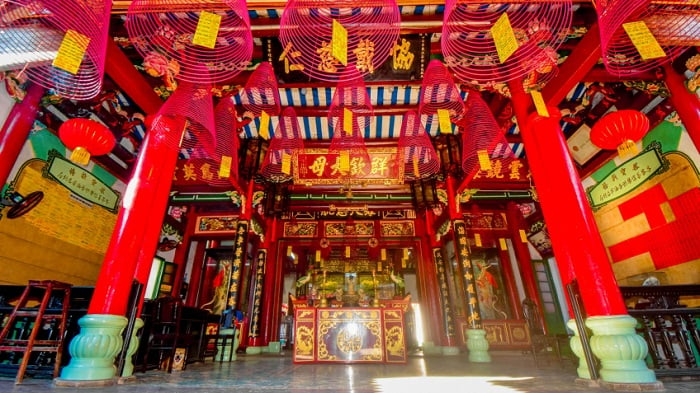
Many of these individuals retreated and brought their families, wives, and children on ships across the sea to Southeast Asia, including Hoi An. Subsequently, they sought permission from the Nguyen dynasty to settle here and established the Minh Huong village. The Chinese community from provinces such as Guangdong, Chaozhou, Hainan, Fukien, etc., coexisted and established assembly halls to support each other.
Directions to Fukian Assembly Hall Hoi An
As mentioned, due to its convenient location right in the center along the main street of the ancient town, getting to the Fukian Assembly Hall is very straightforward.
- If coming from Da Nang, follow Vo Nguyen Giap – Lac Long Quan route. Upon reaching Hoi An, turn right onto Hai Ba Trung, then turn left onto Nguyen Cong Tru – Nguyen Truong To – Le Loi – Phan Chau Trinh, and finally turn right onto Tran Phu to reach the destination.
- If coming from the Japanese Covered Bridge (Hoi An), go straight on Nguyen Thi Minh Khai Street, then turn right onto Phan Chu Trinh, and left onto Tran Phu. The destination is at number 46.
If you’re unfamiliar with the route, you can ask locals living in the vicinity. They are usually enthusiastic about giving directions, and some may even guide you to the location.
Additionally, if you are in Da Nang and need a quick and safe means of transportation, you can book a private car service in Hoi An with a driver through DanangPrivateCar.com’s. The private car service with door-to-door transfer will help you save time on navigation, and on the way, you can also visit famous tourist spots such as Marble Mountains, My Khe Beach, etc. Book your private trip from Da Nang to Hoi An today to fully explore the Fukian Assembly Hall (Phuc Kien).
Ticket Prices and Opening Hours of Fukian Assembly Hall Hoi An
Opening hours for visitors:
- Opening hours: from 7 am to 5 pm from Monday to Friday
These are the specified operating hours of the Fukian Assembly Hall, so visitors should be aware of them if they plan to visit this location. You can visit the assembly hall on any day and at any time within the allowed time frame.
Ticket prices for Fukian Assembly Hall:
Fukian Assembly Hall is part of the 21 tourist attractions in the ancient town. To enter, you need to purchase a ticket for exploring Hoi An’s ancient town. With this ticket, you can explore the assembly hall and choose two additional locations. The specific ticket prices are as follows:
- Ticket price for Vietnamese tourists: 80,000 VND per person
- Ticket price for international tourists: 150,000 VND per person
You can purchase tickets directly at the ticket counter, or if you are on a Hoi An tour, the travel company will take care of it for you. Note that the ticket is valid for use within 24 hours only!
The Best Time to Visit Fukian Assembly Hall Hoi An
As mentioned, the assembly hall is open from Monday to Friday, so you can visit anytime that suits your schedule. Except for rare occasions and the weekends when, in some instances, the assembly hall may close for maintenance purposes.
However, based on travel experience in Hoi An, it’s recommended to visit during events and major festivals. Despite the crowds, the activities are well-prepared and on a larger scale, making your trip more enjoyable.
According to DanangPrivateCar.com, significant events at the assembly hall occur on the 16th and 23rd days of the lunar calendar, which usually fall around March. This period coincides with the dry season in Hoi An, which is considered the best and most ideal time to explore and take photographs, lasting from March to August.
Exploring the Architecture of Fukian Assembly Hall Hoi An
Among the assembly halls in Hoi An, Fukian Assembly Hall possesses the most spacious and beautiful architectural space. Originally built with wood and later renovated with bricks and tiles, the structures and details are intricately designed and crafted.
Tam Quan Gate
The entrance gate, also known as Tam Quan Gate, bears the marks of time. The gate was last renovated in 1975, entirely covered with porcelain, and the curved roof is made of yin-yang tile. It is adorned with imposing winding dragons.
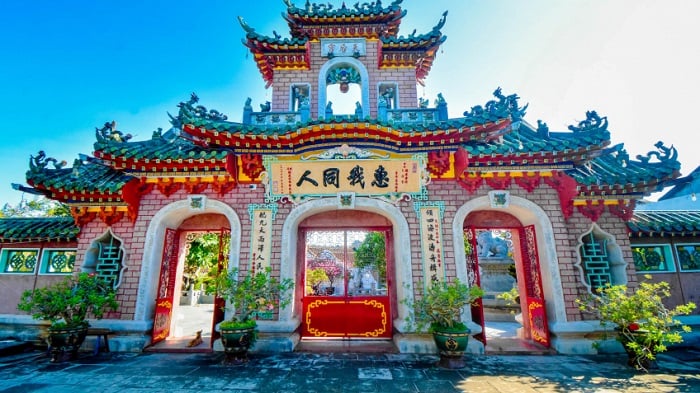
Tam Quan Gate has three paths with three meanings: Heaven – Earth – Human. According to ancient beliefs, to prevent bad energy from entering, the central gate is usually closed, only opened during important events such as weddings, funerals, etc.
Carp Crossing Dragon Gate
Stepping beyond the Tam Quan Gate, visitors will immediately notice a miniature landscape with a statue representing a carp transforming into a dragon, also known as Carp Crossing Dragon Gate.
This is a famous Chinese legend, symbolizing that the carp will bring abundant water to the people here. The intricately carved carp is a vibrant and eye-catching highlight.
Main Sanctuary
The main sanctuary is dedicated to Thien Hau Thanh Mau. On the right and left sides, there are altars for the deities Thien Ly Nhan and Thuan Phong Nghi, who always accompany her to aid and rescue the people.
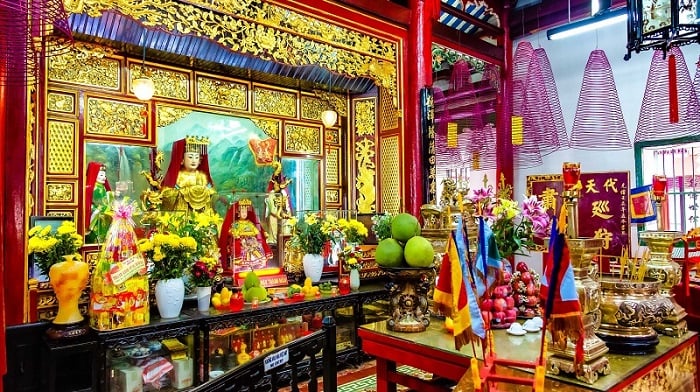
There are also altars for the 12 midwives, three fertility goddesses, etc. All are solemn and sacred, surrounded by many valuable artifacts.
Rear Worship Hall
Moving into the rear worship hall, you’ll find large incense coils. These incense coils can burn for over a month, and if extinguished, they will be lit again.

Visitors often write a paper with their family’s information, place it on the marked incense, and pray for everything to go smoothly. When the incense burns out, the assembly members will burn them, considering the wishes sacred.
Other Activities at Fukian Assembly Hall Hoi An
Photography
Although there are regulations from the management limiting filming and photography in sacred places, it does not mean it’s prohibited. Here, you can choose beautiful and impressive angles for check-in, especially around the Tam Quan Gate, Carp Crossing Dragon Gate, or the area with hanging incense coils. Depending on the context, choose a tilted or straight angle that suits your preference.
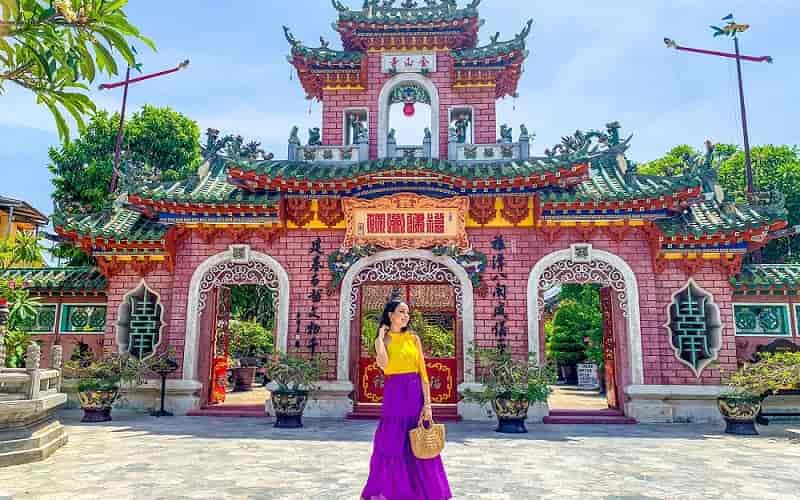
Lighting Incense for Good Fortune
Many believe that Fukian Assembly Hall Hoi An is a sacred place where wishes can be granted. Therefore, not only locals but also foreign visitors often come here to light incense and seek blessings. You can give it a try!
Participating in Lady Thien Hau’s Ceremony
In addition to the prominent festivals in the ancient town, such as the lantern festival (14th day of the lunar month) and Lady Thu Bon Festival (12th day of the 2nd lunar month), visitors also have the opportunity to experience Lady Thien Hau’s Ceremony on the 23rd day of the 2nd lunar month.
Lady Thien Hau’s Ceremony takes place at Fukian Assembly Hall Hoi An with solemn rituals such as bathing the statue, offering incense, vegetarian offerings, and a festive part with various outstanding artistic activities.
What to Eat at Fukian Assembly Hall Hoi An?
Hoi An’s ancient town is not only known for its many tourist attractions but also celebrated as a culinary paradise. After exploring Phuc Kien Assembly Hall, you can venture to various restaurants, eateries, street food stalls, and Hoi An Market to discover the local cuisine.

Some notable dishes include: Cao Lau, Mi Quang, Banh Bao – Banh Vac, Hen Xao, Grilled Rice Paper with Meat, Hoi An Chicken Rice, Banh Mi, Corn Sweet Soup, Mixed Sweet Soup, and more. Each dish is delicious, and the prices are very reasonable.
Suggestions for Nearby Tourist Destinations from Fukian Assembly Hall Hoi An
After concluding your experiences at Fukian Assembly Hall, you can explore other equally famous nearby attractions. DanangPrivateCar.com recommends a few places such as:
Phung Hung Ancient House
Phung Hung Ancient House, with over 240 years of history, was built during the peak of Hoi An’s prosperous and thriving trading port. The house is a combination of architectural styles from three countries: Vietnam, Japan, and China, using rare and precious materials and woods.
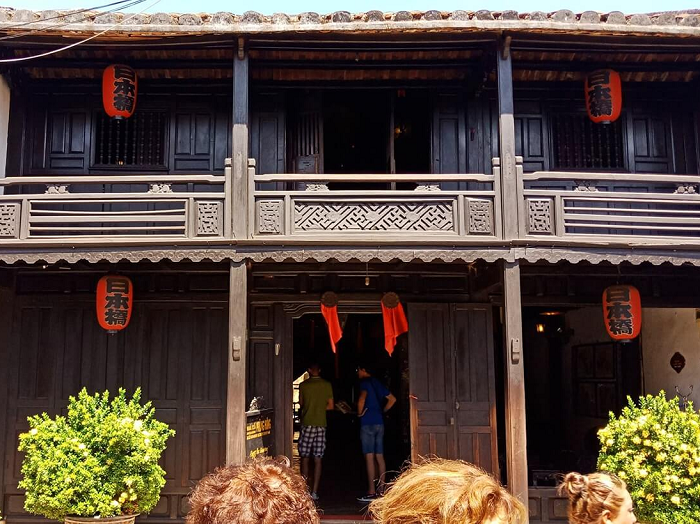
Phung Hung is a nationally recognized ancient house and has become a distinctive tourist destination that attracts many visitors alongside Fukian Assembly Hall.
Japanese Covered Bridge
Considered one of the symbols of Hoi An, the Japanese Covered Bridge is not a temple but a place of worship. It impresses with its architectural style heavily influenced by Japanese culture. The bridge is also featured on the back of the 20,000 Vietnamese dong banknote.
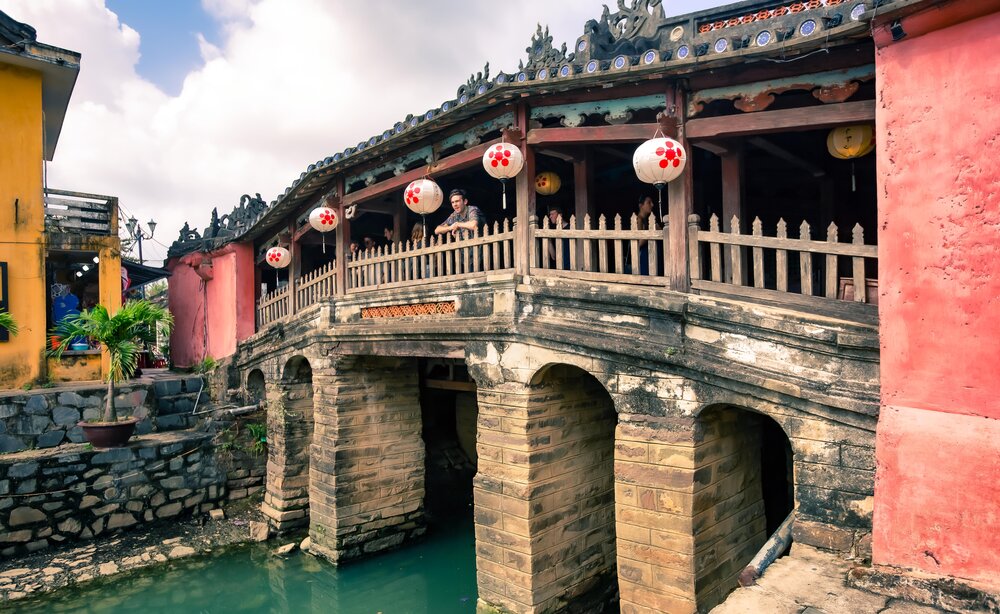
Hoi An Museum of Folk Culture
It would be a miss not to visit this place in Hoi An. The Museum of Folk Culture in Hoi An preserves numerous artifacts of traditional and exceptional educational value.

Here, you can admire the exhibits and materials on display inside, gaining a deeper understanding of the culture and history of Hoi An in bygone times.
Things to Note Before Visiting Fukian Assembly Hall Hoi An
- As a popular tourist destination in the ancient town, Fukian Assembly Hall welcomes hundreds of visitors daily. However, before you come here, there are some important considerations to keep in mind, as shared by DanangPrivateCar.com:
- Fukian Assembly Hall is a spiritual and solemn place. Therefore, pay attention to your attire, which should be polite and not revealing. Avoid laughing, joking, or speaking too loudly to demonstrate your respect for the sanctity of the place.
- This is a place for sightseeing and offering incense. Therefore, absolutely do not bring food, as it may affect the surroundings. Inside, there is an area selling large incense rings and ritual items for visitors to offer, so you don’t need to prepare in advance.
- Travelers should be aware that on holidays or full moon days, Fukian Assembly Hall can be very crowded. During the visit, be cautious about personal belongings to avoid pickpocketing.
- If you prefer not to walk, you can rent a bicycle or take a cyclo to the gate and then walk inside.
- If you want to learn more about this place, you can contact and hire a local guide for around 300,000 VND per group of 8 people.
When in Hoi An, you can stroll through the lantern-lit streets, visit the Japanese Covered Bridge, relax by the Hoai River, and more. However, absolutely do not miss Fukian Assembly Hall (Phuc Kien) Hoi An – a place that not only impresses with fascinating historical stories but also leaves you in awe of its unique architecture. Save this information and explore it right away!

Comments